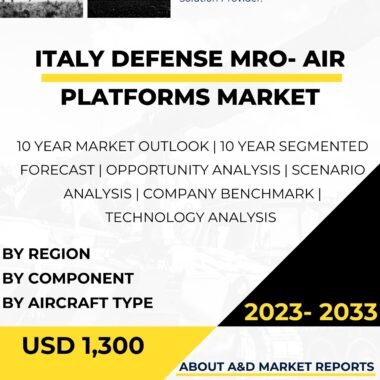Description
The demand for aluminum in the aerospace and defense industry in Malaysia is experiencing significant growth and represents a critical component of the country’s strategic efforts to bolster its aerospace capabilities and national security. Aluminum’s versatility, lightweight properties, and exceptional strength-to-weight ratio make it an essential material for various applications within this sector.
In the aerospace industry, aluminum alloys are widely employed in the construction of aircraft components, including fuselages, wings, and structural elements. Malaysia’s burgeoning aerospace sector, marked by the development of aircraft manufacturing and maintenance facilities, underscores the pivotal role aluminum plays in enhancing aircraft performance and fuel efficiency. Lightweight aluminum alloys contribute to reduced fuel consumption and increased payload capacity, aligning with global trends in sustainable aviation.
Furthermore, the defense industry in Malaysia relies on aluminum for various applications, such as armored vehicles, naval vessels, and military aircraft. Aluminum’s corrosion resistance and durability are particularly advantageous in maritime environments, making it an ideal choice for naval vessels that need to withstand the rigors of sea operations. Its use in military aircraft ensures both structural integrity and performance, critical for national defense and security.
The increasing demand for aluminum in the aerospace and defense industry is not only driven by its material properties but also by Malaysia’s strategic vision for technological self-reliance and defense modernization. The country has made significant investments in research and development, including advancements in aluminum metallurgy and fabrication techniques. These efforts aim to enhance the domestic supply chain for aluminum components, reducing reliance on imports and positioning Malaysia as a competitive player in the global aerospace and defense market.
Moreover, Malaysia’s participation in international collaborations and partnerships has facilitated technology transfer and knowledge exchange, further strengthening its capabilities in utilizing aluminum for aerospace and defense applications. These collaborations enable the country to access cutting-edge aluminum-related technologies and methodologies, driving innovation and expertise development within its domestic industry.
In conclusion, the demand for aluminum in Malaysia’s aerospace and defense industry is on a growth trajectory, fueled by its material advantages and the country’s strategic ambitions. Aluminum’s lightweight properties, strength, and versatility make it an indispensable component in aircraft, naval vessels, and military equipment. Malaysia’s investments in research, development, and international partnerships highlight its commitment to becoming self-reliant and competitive in the global aerospace and defense market. The continued expansion of aluminum usage in these sectors not only contributes to technological advancement but also strengthens Malaysia’s capabilities in safeguarding national interests and security.
Table of content
Table Of Contents
1 Market Introduction
1.1 Market Introduction
1.2 Market Definition
1.3 Market Segmentation
1.4 10 Year Market Outlook
2 Market Technologies
3 Global Market Forecast
3.1 Global Market Forecast
3.2 By Component
3.3 By End User
4 APAC Market Trends & Forecast
4.1 Drivers, Restraints And Challenges
4.2 PEST
4.3 Market Forecast
4.3.1 Market Forecast By Component
4.3.2 Market Forecast By End User
4.4 Scenario Analysis
4.5 Key Companies& Profiling
5 Malaysia Analysis
5.1 Current Levels Of Technology Maturation In This Market
5.2 Market Forecast
5.2.1 Market Forecast By Component
5.2.2 Market Forecast By End User
5.3 Scenario Analysis
5.4 Country Defense Budget (Historical and 10- year forecast)
5.5 Defense Budget Category Spending- 10- year forecast
5.6 Procurement Analysis
5.7 EXIM Data
5.8 Patents
6 Opportunity Matrix
6.1 By Component
6.2 By End User
7 Scenario Analysis
7.1 Scenario 1
7.1.1 By Component (Scenario-1)
7.1.2 By End User(Scenario-1)
7.2 Scenario 2
7.2.1 By Component (Scenario-2)
7.2.2 By End User(Scenario-2)
8 Company Benchmark
9 Strategic Conclusions
10 About Aviation And Defense Market Reports
Segments
By Component
By End Users
List of Tables
Table1: Global Market Forecast, Aluminum demand in Aerospace & Defense Industry
Table2: APAC Market Forecast, Aluminum demand in Aerospace & Defense Industry
Table3: APAC Market Forecast, By Component
Table4: APAC Market Forecast, By End Users
Table5: APAC, Scenario Analysis
Table6: Malaysia Market Forecast, Aluminum demand in Aerospace & Defense Industry
Table7: Malaysia Market Forecast, By Component
Table8: Malaysia Market Forecast, By End Users
Table9: Malaysia, Scenario Analysis
Table 10: Malaysia Defense Budget 10 Year Forecast
Table 11: Malaysia, Defense Budget Category Spending- 10- year forecast
Table 12: Malaysia, Procurement Analysis
Table 13: Malaysia, EXIM Data Analysis
Table 14: Malaysia, Opportunity Analysis, By Component
Table 15: Malaysia, Opportunity Analysis, By End Users
Table 16: Malaysia, Scenario Analysis, By Component
Table 17: Malaysia, Scenario Analysis, By End Users
Figure 1: Market Segmentation, Malaysia Aluminum demand in Aerospace & Defense Industry
Figure 2: Key Technology Analysis, Aluminum demand in Aerospace & Defense Industry
Figure 3: Global Market Forecast, Aluminum demand in Aerospace & Defense Industry
Figure 4: APAC, Market Forecast, Aluminum demand in Aerospace & Defense Industry
Figure 5: APAC, Market Forecast, By Component
Figure 6: APAC, Market Forecast, By End Users
Figure 7: APAC, Scenario Analysis
Figure 8: Malaysia, Market Forecast, Aluminum demand in Aerospace & Defense Industry
Figure 9: Malaysia, Market Forecast, By Component
Figure 10: Malaysia, Market Forecast, By End Users
Figure 11: Malaysia, Scenario Analysis
Figure 12: Malaysia, Defense Budget 10 Year Forecast
Figure 13: Malaysia, Defense Budget Category Spending- 10- year forecast
Figure 14: Malaysia, Procurement Analysis
Figure 15: Malaysia, EXIM Data Analysis
Figure 16: Malaysia, Opportunity Analysis, By Component
Figure 17: Malaysia, Opportunity Analysis, By End Users
Figure 18: Malaysia, Scenario Analysis, By Component
Figure 19: Malaysia, Scenario Analysis, By End Users
Figure 20: Company Benchmark




